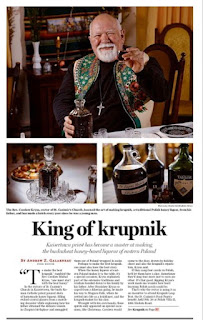Landmark Art, Architecture & Worship: 90 Years and Going
St
Casimir Church Celebrates 90th Year – Sun May 5, 2019
From
the moment Fr Anthony Majewski began conceiving a third Church for Kaisertown’s
PolAm community, St Casimir’s became unique. A Notre Dame University grad with
a Master’s in Theology (rare those days among priests), he set out to discover
the most famous churches of the Mediterranean basin. He knew well this body of
water eye-witnessed the Birth and Resurrection of Jesus. It cradled
Christianity. There he went for origins and inspiration.
For
this reason, it took three blueprint plans to capture something original not
only for Buffalo, but for America. Working closely with the creative genius and
local architect Chester Oakley (pic below); Fr Majewski did not want to construct another
neo-gothic, nor baroque revival church common on Buffalo’s East side. These
far-sighted men agreed something yet unknown at the time to Roaring 20s Roman
Catholics, would, in the words of the Pastor, “inspire people to look beyond,
to look above the things of this earth.”
Hence,
the first US Byzantine-style parish church was born in Buffalo. National media
hailed it as matchlessness, naming Buffalo: “America’s City of Churches.” Since 1926, others have followed these
dreamers lead, the greatest of them built the National Shrine of the Immaculate
Conception in Washington, DC.
What
are the unique architectural features of Byzantine brilliance found at St
Casimir’s? Eastern sacred sites boast of
many domes. A 24-window clerestory supports a Great Dome, depicting God, the
Creator of a global church. Lesser domes cap devotional chapels: such as the
western-facing, Polish-originated, 1929, Częstochowa Icon Shrine; the Baptistry; and the eastward facing, world’s-first, Domestic Church
Shrine (Family Vine Memorial, 2015) and the Divine Mercy Chapel. The Vine Chapel and Shrine are the work of 4 generations of Buffalo's Świątek Family Studios. These two latter chapels feature separate ensembles of pews creating a worship space for First Friday
Masses and Eucharistic Adoration. Similar domes and chapels are found at DC’s
National Shrine.
Additional
domes rise over towers marked with interior faux-galleries; representing the
four corners of the earth. These support the Major Dome Globe.
Oakley’s personal signature consists of wood-carved, polychromed, art-deco angels; indoor and outdoor earth-tone brick; terracotta, dome tilework and extensive faith symbols. PolAm architect Joseph Fronczak of WNY installed these characteristic touches.
Oakley’s personal signature consists of wood-carved, polychromed, art-deco angels; indoor and outdoor earth-tone brick; terracotta, dome tilework and extensive faith symbols. PolAm architect Joseph Fronczak of WNY installed these characteristic touches.
Other
features common to ancient 4-6th century Mediterreanean Basilicas are sanctuary
apses rising high above a baldacchino-capped altar, patron saint image, and
facing choir stalls set aside for liturgical ministers. This Coronation Apse, presents
the world-class vision of the PolAm artist Marian Rzeźnik,
molding ancient Christianity with modern Renaissance.
Henry
Świątek of Buffalo’s Świątek Studios, has traced Rzeźnik’s style to the 16th century School of
Raffaello Sanzio of Disputa fame.
Rzeźnik followed Sanzio’s painting and style, at Buffalo’s Corpus Christi, and the
“Polish Disputa” of St Casimir Church in Cleveland, OH. Majewski’s choice of this
globally intuitive artist, over more ethnic-inspired contemporaries, points to his unique take
on farther-reaching, global art and architecture forms for Kaisertown.
Upon
entering St Casimir’s in Buffalo, the Coronation apse lifts one’s eyes
heavenward. Admittance western doors or Gates of Heaven into God's Home on earth reveals the destiny of the Baptized: the Heavenly Household:
Father, Son, and Holy Spirit. Herein lies a coronation event: the Father crowns His Daughter, the Son His
Mother, and the Spirit His Spouse. The Blessed Trinity proclaims Mary, Queen and First
Lady of Heaven. Witnessing this event, the Church’s own patron
lays aside his princely crown and with an angelic orchestra chants on, from his apotheosis,
or final height of glory.
Today,
this Kaisertown church attracts young twenty-somethings not only into the
sacred Heaven and Earth building, but also to celebrate “beautiful, reverent,
and inspiring liturgies,” as Bishop Malone noted during Sunday’s 90th
Anniversary coram episcopo Mass. He
challenged all present to lead young people here, to what they truly seek, and
“they’ll get hooked.”
In
the last 2 plus years, the bishop’s words are already ringing true. Younger families have sought fully Catholic,
five-sense, celebrations with quality pipe-organ music provided by music
director, Emma Dus. Thus, St Casimir’s welcomed
their son, Dr Thomas Witakowski, and fellow Casimirites of the 120 year Chopin
Singing Society, to lead the 90th Anniversary Mass.
This series examined the distinctive history, singular architecture and
art, modern-day heritage and outreach evangelization mission of Buffalo’s only
free-standing church. St Casimir’s celebrates today’s Gospel challenges daily: working and praying for the good of others.












Comments
Post a Comment